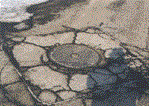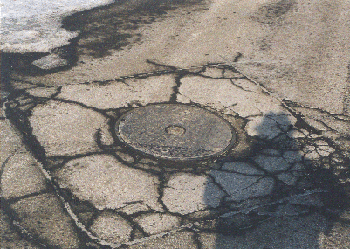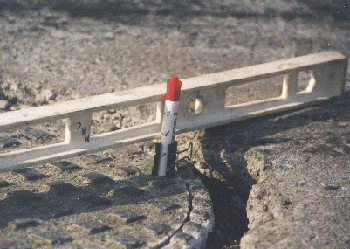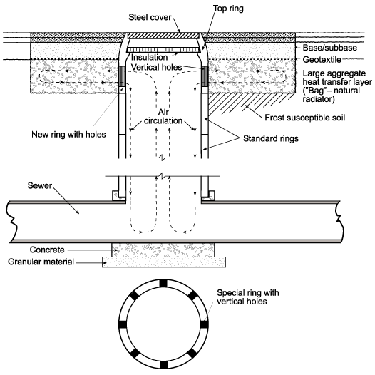Simple manhole innovation cuts frost heave in pavement

The National Research Council's Institute for Research in Construction (IRC) has developed an innovation that will prevent heaving and cracking of pavement around manholes.

Typical cracking caused by frost is seen around a manhole.
Frost damage around manholes is a common sight in many parts of the world, from the northern United States to Canada to Europe and northern Asia. When one considers the number of municipalities plagued by frost damage and the number of manholes in each, the cost of the problem can readily be seen.

Here is an example of asphalt uplift and damage around a manhole.
IRC's solution, developed by researcher Otto Svec, is so simple that one could say it has been staring us in the face all these years. The simplicity lies in harnessing and utilizing the natural warmth of the water flowing through storm and sanitary sewers. The technique promotes convection, which causes warm air to rise upwards in the manhole.33 Near the surface, the warmth is encouraged to radiate horizontally outwards, where it can protect the soil around the manhole from frost. The pavement immediately above suffers less stress, and will not be inclined to heave.
The principle of the thing
Harnessing the warmth in the sewers is accomplished by changing the design of the manhole and altering the surrounding soil. The design modifications involve plugging the holes in the steel manhole cover, adding a layer of insulation below the cover and replacing the conventional concrete rings near the top of the manhole with a single ring containing eight narrow slots. These modifications cause the warmer air to flow out through the slots.
By modifying the ground beyond the slots, the warm air can dissipate beneath the pavement one or two metres in all directions. This is accomplished by placing a layer of large, clean, crushed stones around the manhole. The air flowing through the spaces between the stones is capable of transferring the warmth farther outwards than is possible with the more common soils containing clay.
Concept proven in field study
With any proposed innovation such as this (see drawing), municipalities and utility companies are naturally concerned about performance and cost. To prove its concept in a real-life setting, IRC carried out a field test with engineers in the City of Nepean, next door to Ottawa.

The innovative concept for front heave mitigation around manholes is illustrated here.
Despite fluctuating temperatures during the winter, de-icing salt applied to city streets, and wear and tear from vehicles, the IRC innovation worked like a charm. At winter's end, the pavement around the test manhole remained flat and free of cracks. This was in sharp contrast to pavement around standard manholes, some of which heaved by five centimetres.
In addition to performing well, the news on cost is also good: the slotted cement rings can be easily manufactured, and the entire installation procedure costs little more than conventional manhole construction, or reconstruction, techniques. Indications are that by extending the life of pavement by just one or two years, municipalities can recoup their investment. The expectation is that pavement protected in this way will last as long as pavement where frost is not a concern.
Widespread adoption of this innovation in new road construction holds great potential for saving money because of the much lower incidence of repairs. Secondary benefits include less traffic disruption and damage to vehicles, as well as energy savings and environmental advantages (less material used, fewer emissions produced).
IRC has applied for an international patent on its innovation and is exploring commercial opportunities.
Meanwhile, research will turn to making the technology as cost effective as possible.33Specific technical questions can be directed to Dr. Otto J. Svec at (613) 993-3806, fax (613) 954-5984, or e-mail otto.svec@nrc.ca.If you would like to discuss licensing opportunities, please contact Mr. Jim Nolen, IRC's Marketing Manager, at (613) 993-3772, fax (613) 993-3142, or e-mail jim.nolen@nrc.ca.
Reprinted with permission from Construction Innovation published by the National Research Council of Canada, Institute for Research in Construction.
